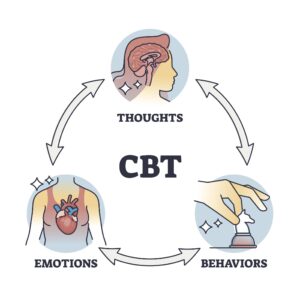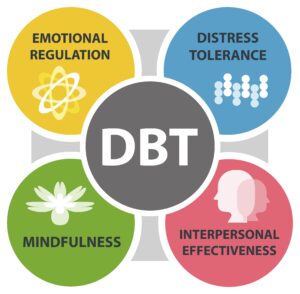If you’ve been feeling anxious or depressed lately, you’re not alone. Depression and anxiety are on the rise in the U.S. According to the National Alliance on Mental Illness (NAMI), anxiety disorders and major depression are the most common mental health disorders in the country. Without treatment, outcomes for these disorders can only get worse.

Alarming Statistics
According to Mental Health America (MHA), over 50 million adult Americans, or 20.78%, were experiencing a mental illness in 2019-2020. Key findings of MHA’s 2023 The State of Mental Health in America report show that over 1 in 10 youth individuals experienced depression severe enough to significantly impair their ability to function at school, home, work or in their social life. Of those ages 12-17, 16.39% reported suffering from at least one major depression episode (MDE) in the past year, and over 2.7 million youth have experienced major depression.

Anxiety disorders are the most common disorders in the U.S., followed by major depressive disorder. According to statistics by the Anxiety & Depression Association of America (ADAA), 40 million adults, or 19.1% of the population, are affected by anxiety disorders every year. Anxiety disorders also affect 31.9% of adolescents ages 13-18. Research has shown that teenagers with untreated anxiety disorders are at a higher risk for performing poorly in school, missing out on important social experiences, or experiencing substance abuse, according to ADAA. Generalized anxiety disorder (GAD) is the most common anxiety disorder in the U.S.
Unfortunately, an alarming number of people suffering with a mental illness do not receive mental healthcare treatment. Research conducted by the Substance Abuse and Mental Health Services Administration (SAMHSA) shows that approximately 60% of adults with a mental illness didn’t receive mental health treatment in the year prior to the study. As much as half of youth ages 8-15 with mental health issues also went without treatment the year prior. Mental healthcare treatment was also inequitable—in the time frame the research was conducted—Black and Hispanic Americans received mental healthcare services at close to half the rate of white Americans and Asian Americans received mental healthcare services at about ⅓ of the same rate as white Americans.
Fortunately, a rise in remote treatment options, such as Valera Health’s telemental health services, are helping to fill in the gaps care.


Popular Forms of Treatment For Depression & Anxiety
Oftentimes, anxiety and depression disorders are co-occurring, and various approaches to psychotherapy have been developed to treat them both. Among the most popular types of therapy for treating both anxiety disorders and depressive disorders are cognitive behavioral therapy (CBT) and dialectical behavior therapy (DBT), which are considered to be “gold standards” among psychologists.
CBT has been shown to be an effective treatment for treating both anxiety and depression symptoms, with a success rate between 50-75%. In CBT, a patient works with a therapist in a structured setting. The main goal of CBT is to help individuals become aware of negative thought patterns and equip them with the tools to challenge and overcome these negative thought patterns, reframing them in a positive and helpful way.
Another bonus is that CBT is a short-term therapy, which can take as few as six sessions to complete. However, the suggested duration of treatment can vary on an individual basis. For more information about the benefits of CBT, check out this article by the Mayo Clinic.
While DBT is rooted in CBT practices, there are a few key differences between the two. Both focus on equipping individuals with tools they need to improve outcomes of depressive disorders and anxiety disorders. One difference between DBT and CBT, however, is the philosophy behind each.
CBT is a more problem-focused approach to therapy, with the aim to change negative thought patterns and behaviors that contribute to mental health symptoms. DBT, on the other hand, takes the approach of emphasizing the importance of accepting and validating emotions and can improve stress tolerance, emotional regulation and more. DBT also incorporates mindfulness and grounding practices.
Unlike CBT, DBT requires a longer duration of treatment. Typically, patients undergoing DBT are recommended to spend six months to a year in this type of treatment. Like CBT, DBT has a high success rate in treating both depressive symptoms and anxiety symptoms.
DBT has also been shown to be highly effective in treating Borderline Personality Disorder (BPD), with one study showing improved BPD outcomes so much that after a full cycle of DBT treatment, 77% of study participants no longer met the criteria for a BPD diagnosis.
While CBT and DBT do not necessarily cure anxiety disorders and depressive disorders, they have a proven track record of improving anxiety symptoms and symptoms of depression, as well as improving outcomes for a wide variety of other mental health disorders.
If you’re interested in learning more about warning signs of clinical depression, click here, and warning signs of anxiety, click here.

Valera Health Can Help
If you are interested in joining Valera Health’s Conscious Parenting Group, please fill out this quick form to schedule a free consultation with a designated Health Connector. Make sure to select “group therapy” under the “What brings you to therapy today?” section. Please note that at this current time, our virtual Conscious Parenting Group is only available to those in New York. Stay tuned for more group therapy offerings from Valera Health in the future.
Works Referenced:
Berge, J. M., Law, D. D., Johnson, J., & Wells, M. G. (2010). Effectiveness of a psychoeducational parenting group on child, parent, and family behavior: a pilot study in a family practice clinic with an underserved population. Families, Systems, & Health, 28(3), 224.
Friedrich, M. (2020, December 2). Census Bureau Releases New Estimates on America’s Families and Living Arrangements. census.gov. Retrieved April 18, 2023, from https://www.census.gov/newsroom/press-releases/2020/estimates-families-living-arrangements.html#:~:text=2%2C%202020%20%E2%80%94%20Newly%20released%20estimates,2010%20to%2063.1%20million%20in
Izadi-Mazidi, M., Riahi, F., & Khajeddin, N. (2015). Effect of cognitive behavior group therapy on parenting stress in mothers of children with autism. Iranian journal of psychiatry and behavioral sciences, 9(3).
Minjarez, Mendy Boettcher, et al. “Impact of pivotal response training group therapy on stress and empowerment in parents of children with autism.” Journal of Positive Behavior Interventions 15.2 (2013): 71-78.